The Labour Rights Index Methodology
The Labour Rights Index (LRI) scores 145 countries across ten indicators that span fair wages, decent working hours, employment security, family responsibility, maternity at work, social security, forced labour and a worker’s access to trade union and freedom of association. Each indicator is made up of four to five binary questions that assess the country's legislation and legal provisions on its ability to guarantee a specific right to its worker. Under the Employment Security indicator, for instance, this would look like this:
- Does the law require a written employment contract or employment particulars to be given to a worker on commencement of employment?
- Does the law restrict the hiring of fixed-term contract workers?
- Does the law limit the length of the probation period, including renewals, to three months?
- Does the law require a 30-day notice period before employment contract termination?
- Does the law require severance pay at the rate of at least two weeks of wages for every year of service?
Each question will be answered as Yes (1) or No (0) against a specific criterion detailed within the methodology.
This score is then scaled to 100. The final score of a country is a simple average of all ten indicators.
The Limits of the Index
As each indicator with its relevant questions (46 in total) assesses a country on legislation and legal text, the LRI fails to capture the on-ground realities present in the application of the law. Having robust legislation that declares that workers will be provided with employment contracts, sets limits to the use of a fixed-term contract, and states that the probation period should be less than three months along with a guarantee of notice period followed by the provision of severance pay does not necessarily translate to execution.This can be caused by a flawed democracy, a weak labour inspectorate system or simply because of a dominant informal sector that falls outside the power of the law amongst many reasons. However, the chasm between legislation and its application boils down in essence to a weak rule of the law.
Accounting for Reality
-
LRI-Normalized Heat Map
We normalise the LRI scores using the min-max method and then scaling the score to 100. To bridge the gap between the de jure labour rights and the de facto situation, the index is used in conjunction with data on the legitimacy or effectiveness of laws in practice.
This is done by combining the LRI score with a multitude of additional indexes and data sources.
-
World Justice Project (WJP)
Factor 6 of the World Justice Project (WJP)’s Rule of Law Index measures the regulatory enforcement of the law in a country.[37] It scores between 0 and 1 with a lower score indicating a weaker adherence to the rule of law. We create a composite index by calculating a new score as a product of Factor 6 and the LRI score: LRI scored adjusted under the Ruel of Law Index is given by:
| Normalised (min-max) |
[Factor 6 of the Rule of Law Index X LRI score] |
-
Size of Formal Sector
The size of the formal sector allows for the assessment of the proportion of the labour force that is under the jurisdiction of the legislation. A high score on the Labour Rights Index might not be as impactful if the laws assessed only protect a minority of workers. To rectify this, we create a composite index by calculating a new score as a product of the formal sector[38] as a percentage of the workforce and the LRI score:
LRI scored adjusted under the formal sector size is given by:
| Normalised (min-max) | [Formal Sector(%age) X LRI score] |
-
Worldwide Governance Indicators (WGI)
The Rule of Law dimension of the Worldwide Governance Indicators (WGI) by the World Bank captures perceptions of the extent to which agents have confidence in and abide by the rules of society, and in particular the quality of contract enforcement, property rights, the police, and the courts, as well as the likelihood of crime and violence.[39]
The scores under WGI range from approximately
-2.5 (weak) to 2.5 (strong) governance performance which has been readjusted from 0 (weak) to 5 (strong performance).
We create a composite index by calculating a new score as a product of the Rule of Law dimension and the LRI score:
LRI scored adjusted under the formal sector size is given by:
| Normalised (min-max) | [((0.2 x Rule of Law dimension) on WGI + 0.5) X LRI score] |
-
Sustainable Development Goal 8.8.2
SDG indicator 8.8.2, calculated by the ILO, ranges from 0 to 10, with 0 being the best possible score and 10 the worst, indicating levels of compliance with Freedom of Association and Collective Bargaining rights. The score on Freedom of Association indicator of the LRI is replaced with the scaled score under SDG 8.8.2.[40]
To account for the de facto trade union rights present in a country, the we calculate a new score as follows:
| Normalised (min-max) | {∑ (9 indicators) + [(1 - SDG 8.8.2)*100]} ÷ 10 } |
Final Output
This allows for the creation of four additional heat maps. Each adds a layer of context and granularity and provides an additional lens through which the end-user may interpret the Labour Rights Index.
However, no data set looks at each country assessed in the LRI. This leads to missing values in the resulting graphs. Until the Index extends to assessing the de facto application, composite indexes with missing values will have to act as a stopgap.
Labour Rights Index 2024: Original Heatmap
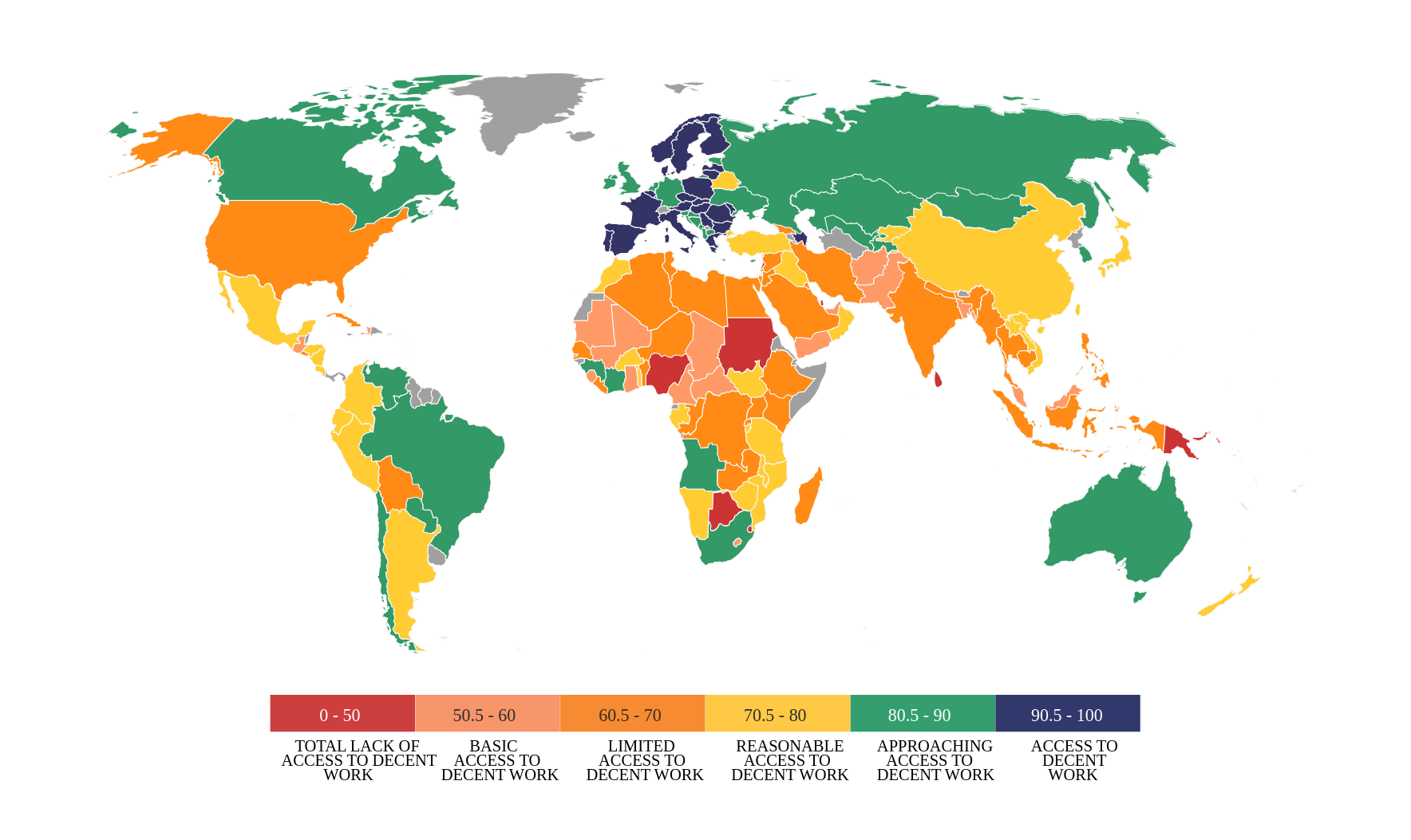
This map is the original heat map of the 145 countries, covered under the Labour Rights Index 2024. This map shows the data as it is without any normlisation technique applied to this data.
Please check it here: https://labourrightsindex.org/2024/heatmap-2024
Labour Rights Index 2024: Normalised Heatmap
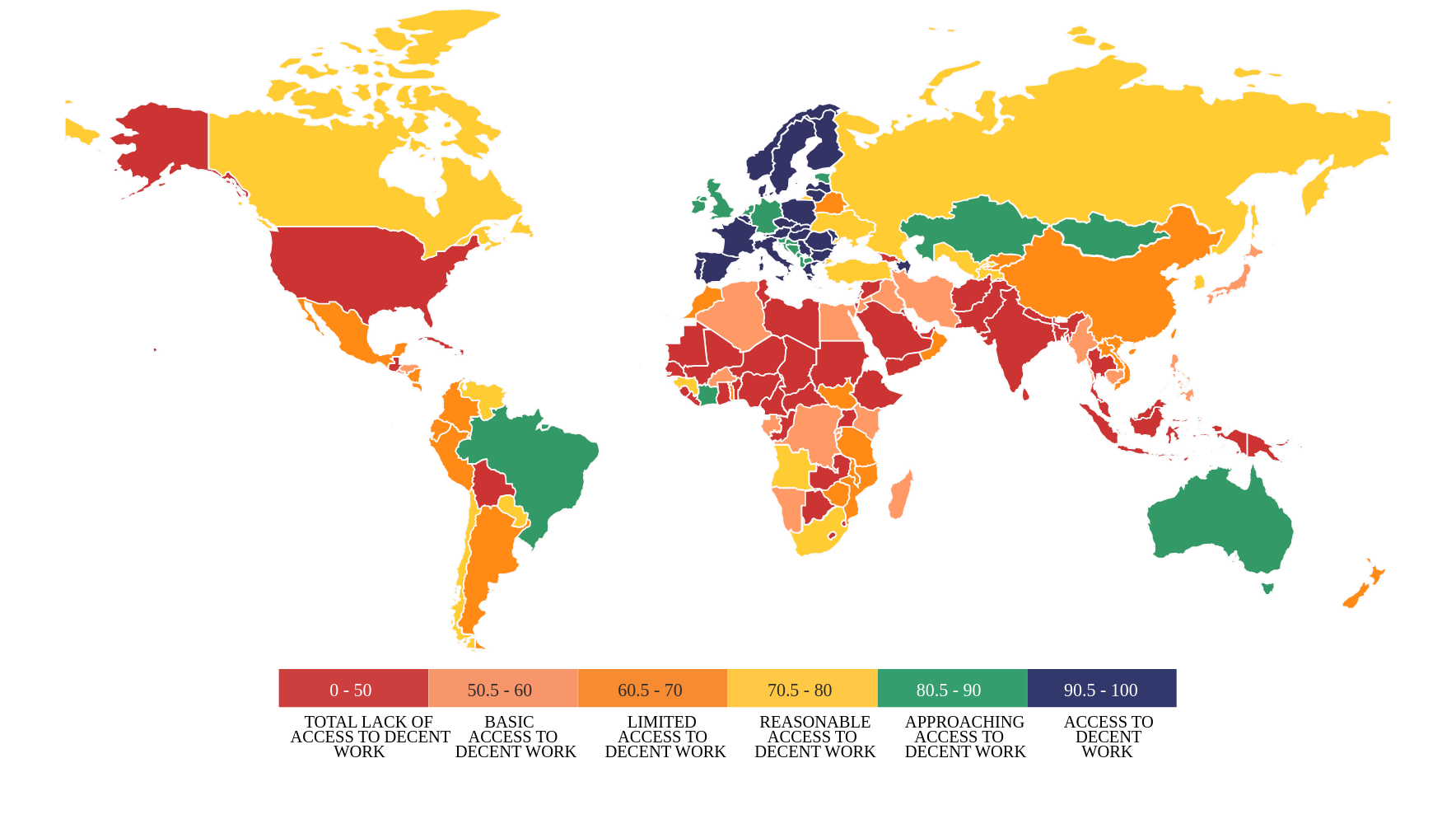
This map shows normalised scores from the Labour Rights Index 2024 for 145 countries by using the min-max method.
Labour Rights Index 2024 - World Justice Project Heatmap
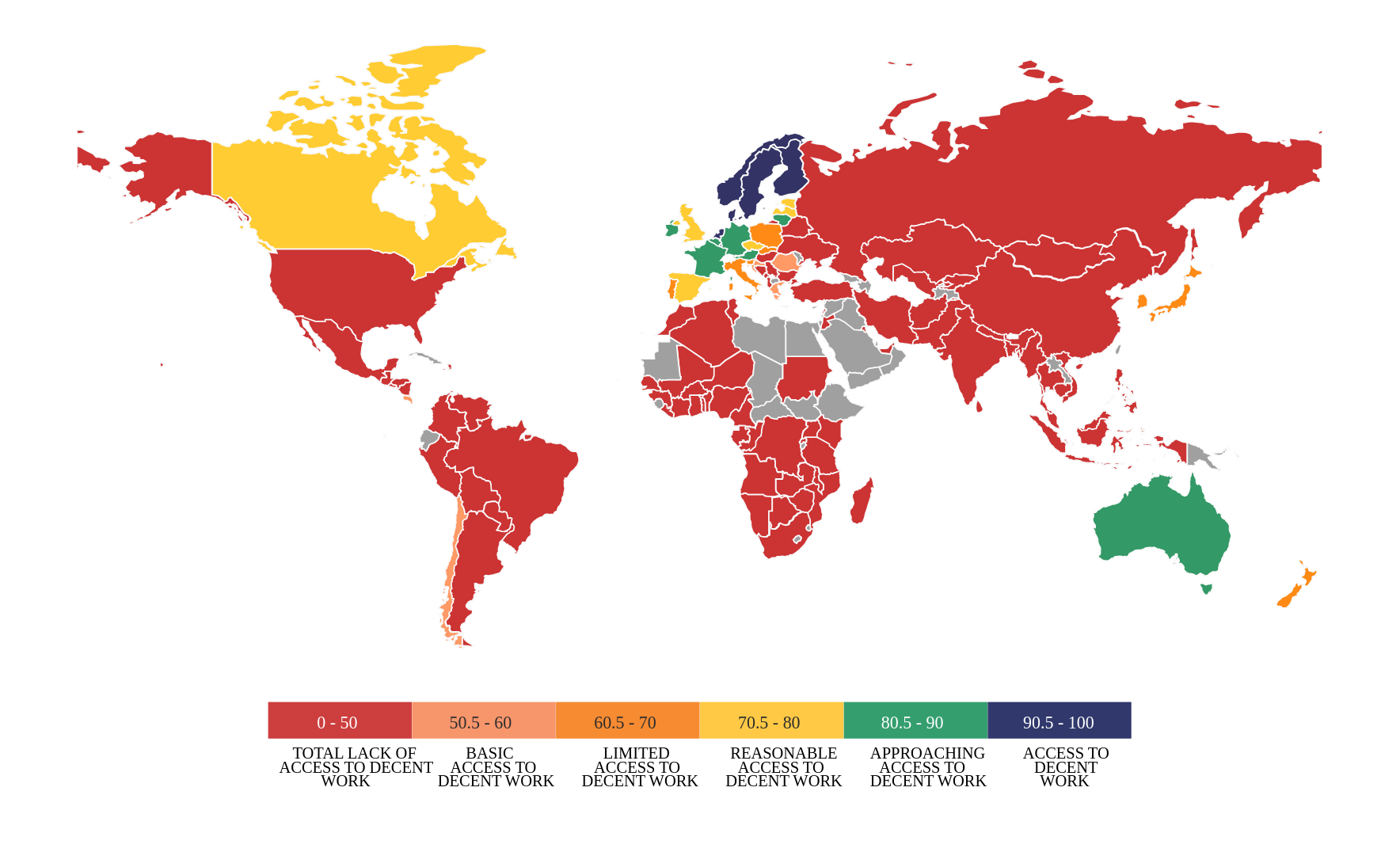
This map is a product of the LRI overall score (0-100) and country score on Factor 6 (0-1), measuring regulatory enforcement from the Rule of Law Index of the World Justice Project. The scores are normalised using the min-max method and scaled to 100. The latest WJP data (2023) is, however, available only in 124 of the 145 LRI countries. The Labour Rights Index data is from the 2024 Index.
For more information about the WJP's Rule of Law Index, please follow the link: https://worldjusticeproject.org/rule-of-law-index/factors/2023/Regulatory%20Enforcement/
Labour Rights Index - SDG 8.3.1 Heatmap
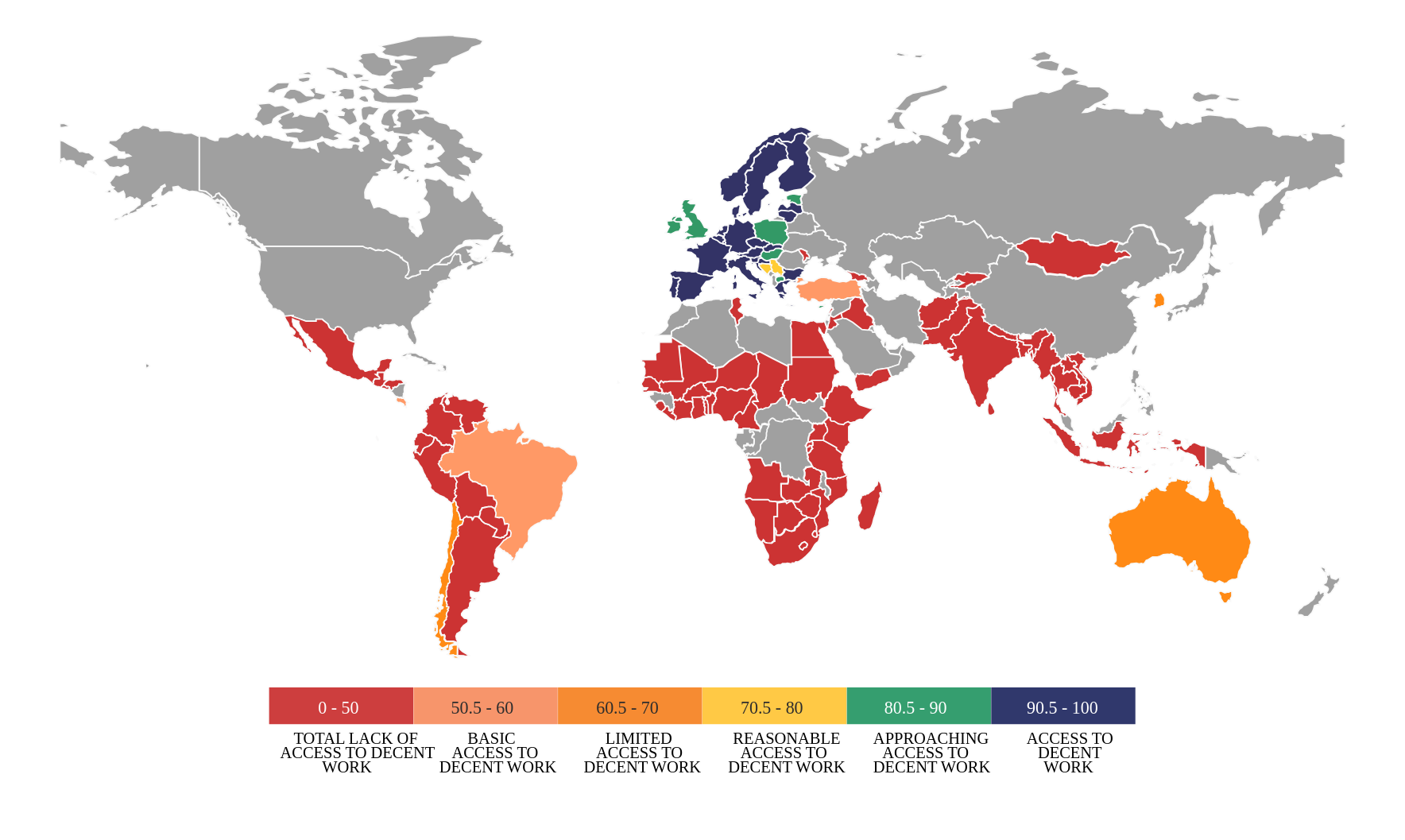
This map is a product of the Labour Rights Index 2024 overall score (0-100) and the proportion of formal employment in total employment in the country. The scores are normalised using the min-max method and scaled to 100. The proportion of formal employment is indirectly derived from the latest country value on Sustainable Development Goal (SDG) indicator 8.3.1, computed by ILO. Data is, however, available only in 102 of the 145 LRI countries. The Labour Rights Index data is from the 2024 Index.
For more information about the SDG Indicator 8.3.1 on proportion of informal employment in total employment, please follow the link:
Labour Rights Index - WGI Heatmap
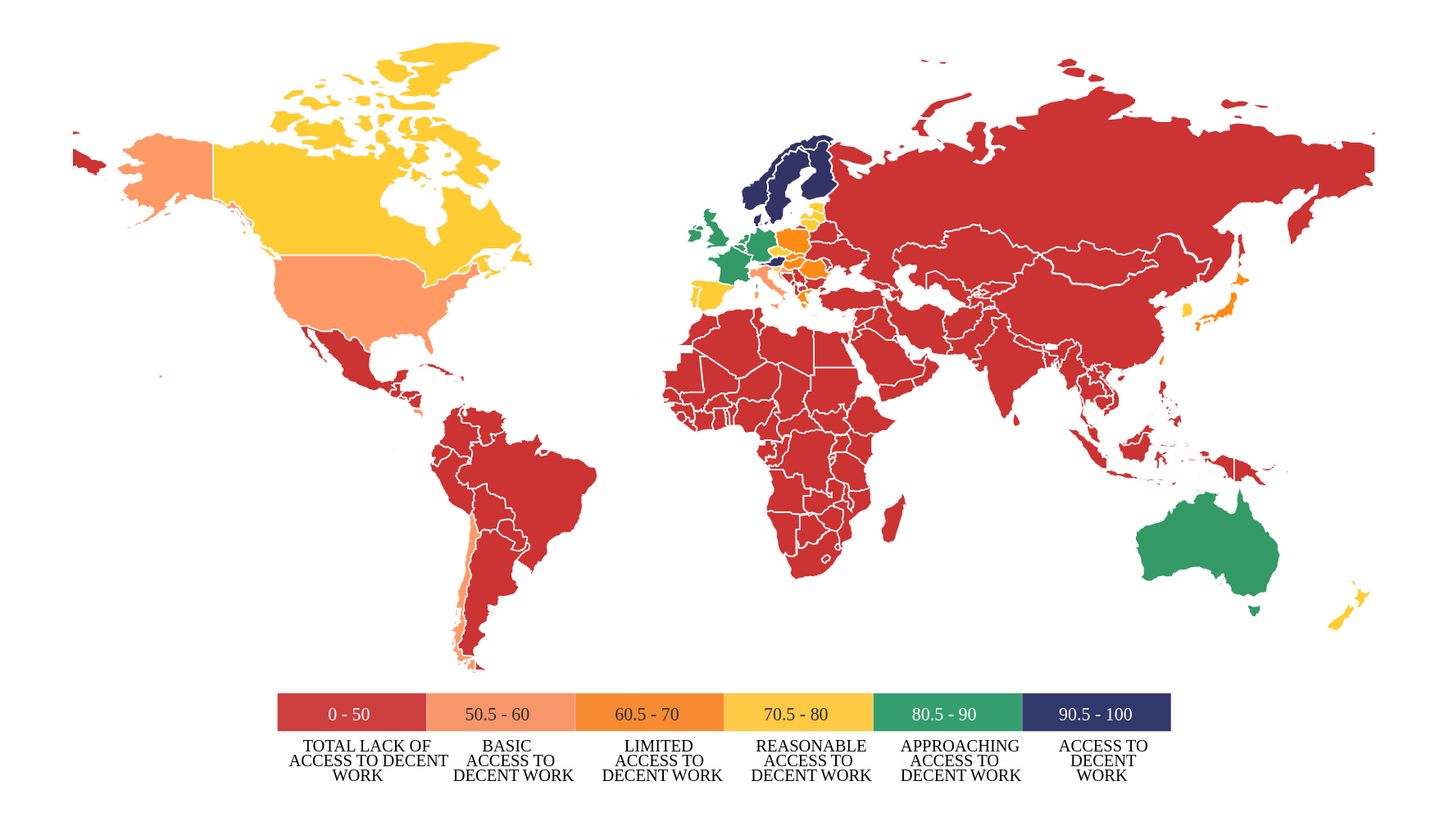
This map is a product of the LRI overall score and the scaled score on the Rule of Law dimension ofthe Worldwide Governance Indicators (WGI) by the World Bank. The scores under WGI range from approximately -2.5 (weak) to 2.5 (strong) governance performance. These are readjusted from 0 (weak) to 5 (strong performance). The final scores are normalised using the min-max method and scaled to 100. WGl data is available for all LRI countries. The WGI data is available for 2023. The Labour Rights Index 2024 data is used to create this map.
For more information about the World Governance Indicators, please follow the link: hhttps://www.worldbank.org/en/publication/worldwide-governance-indicators
Labour Rights Index - SDG 8.8.2 Heatmap
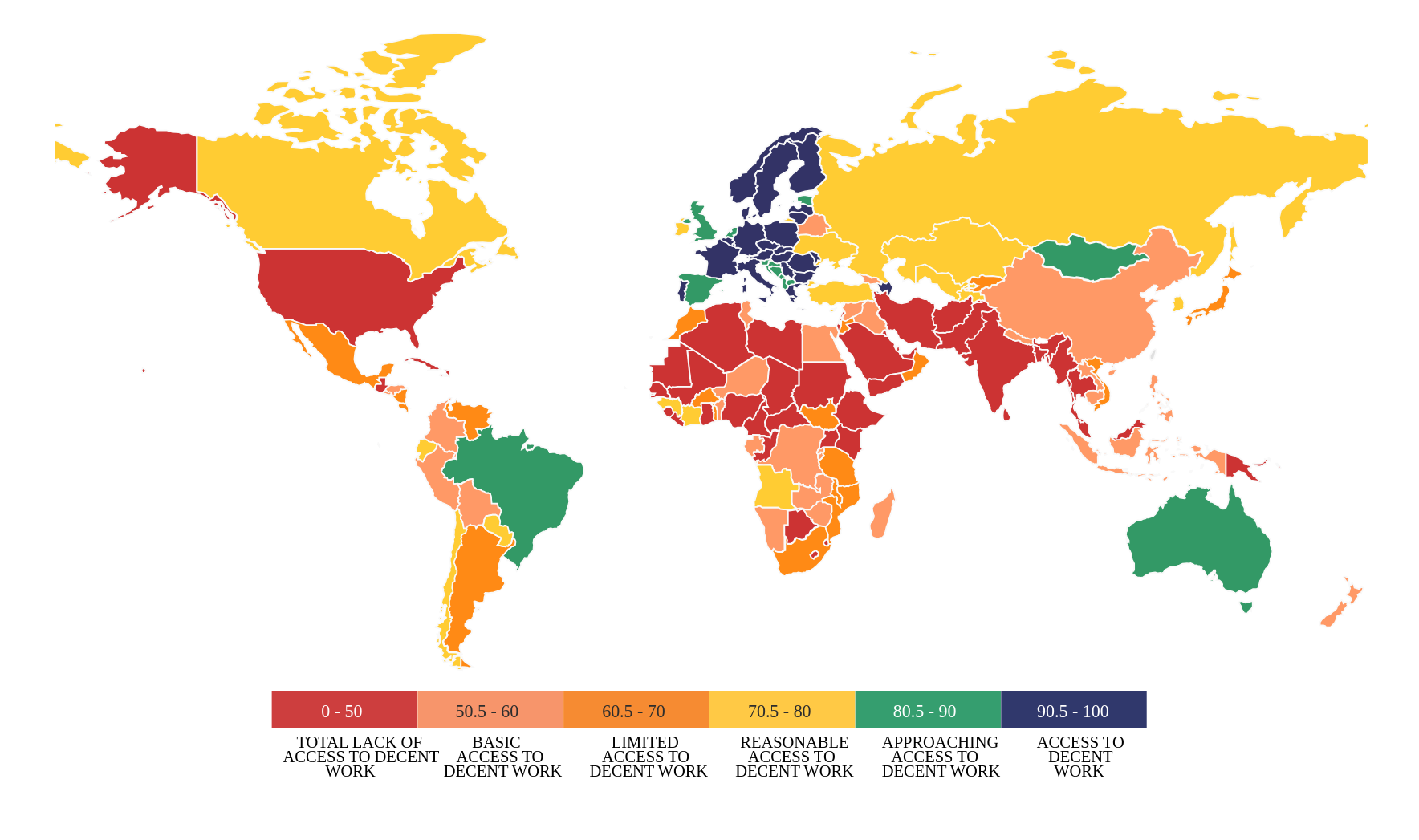
This map is created while using the latest country score on Sustainable Development Goal (SDG) 8.8.2 (after indirectly calculating the levels of compliance with FACB rights and scaling the result to 100) instead of the LRI's own freedom of Association indicator score to account for the de facto trade union rights present in a country. SDG indicator 8.8.2, calculated by the ILO, ranges from 0 to 10, with 0 being the best possible score and 10 the worst, indicating levels of compliance with Freedom of Association and Collective Bargaining rights). The final scores are normalised using the min-max method and scaled to 100. Data is available for all LRI countries, except Taiwan. The Labour Rights Index 2024 data is used to create this map.
For more information about the SDG Indicator 8.8.2 on the level of national compliance with labour rights (FOA& CB), please follow the link:
